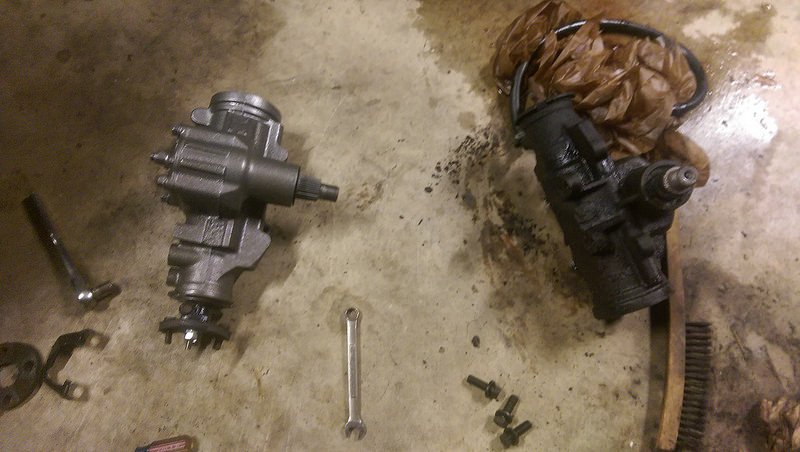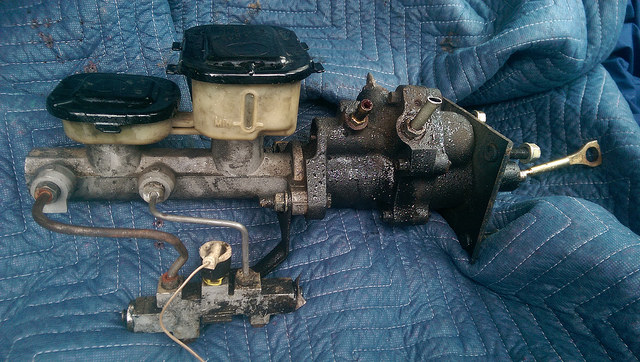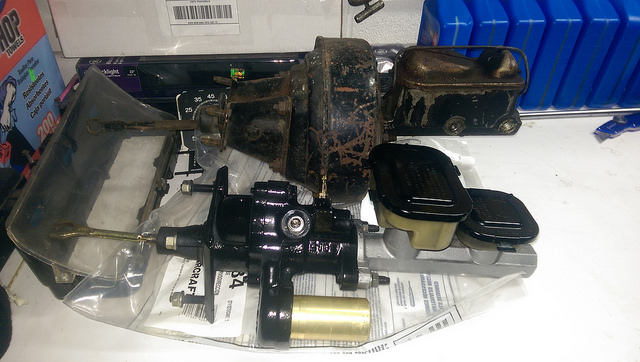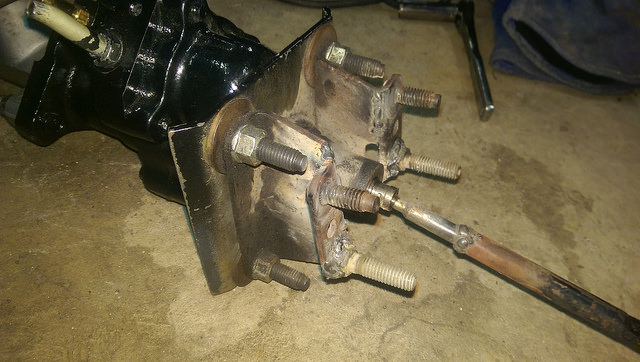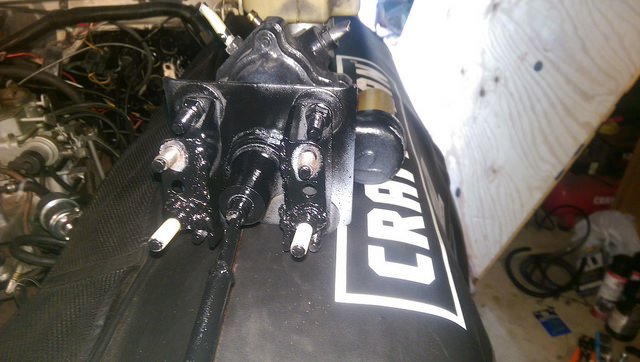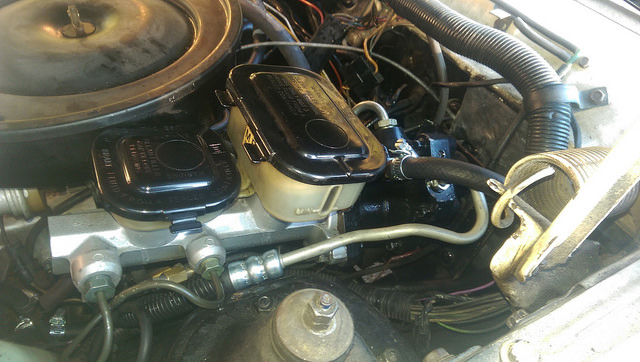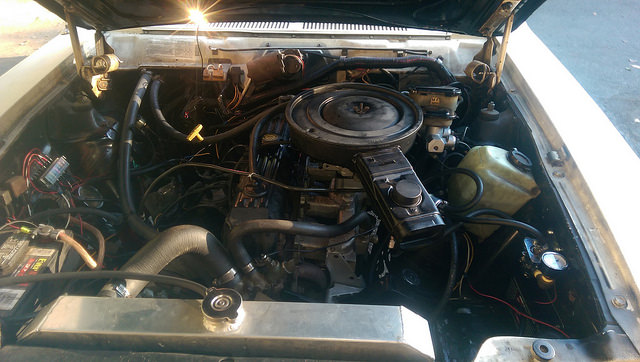Junkyard Hydroboost in an Eagle
By AMC Eagle Den member Baskinator.
Have you had problems with your brakes killing the engine? Have you been going through master cylinders, only to end up with mediocre brake power?
After 2 vacuum boosters, 4 master cylinders, loss of vacuum when brakes were applied, and very poor brake performance, I finally decided to install a GM Hydroboost brake booster in my Eagle. The results are phenomenal: firm, powerful brakes, no parasitic vacuum loss, extended power brake uses if the engine dies, and a seatbelt that locks up before the drums do.
The Eagle, like most cars, uses a vacuum power brake booster. This uses engine vacuum to assist the brakes. The GM Hydroboost instead uses power steering pressure to assist the brakes. This provides a huge increase in pressure to the pads and shoes, and gives 3 emergency power brake assists in the case of an engine shut down.
- Before proceeding with this swap, be aware that it will take some minor fab work and the ability to bend 3/8" steel line. I have not yet extensively tested this, but I am confident that it will be much more reliable than the stock booster and master cylinder. It can be done easier and better for a lot more money, but this will suit most people just fine. Furthermore, replacement units will be easily available and practically "bolt on" when the swap is finished. If you have a stock air cleaner setup, it might be more challenging due to clearance and space issues.
Required Materials:
-Hydroboost Unit and Master cylinder from 1990s GMC Safari/Chevy Astro Van (Not the version with a steep angle!) -4' of 3/8" Rubber Power Steering Hose -Edelman P/N 92084 High Pressure P/S Line (16mm Male O-Ring to 18mm Male O-Ring) -Stock Eagle High Pressure P/S Line (16mm Male O-Ring to 18mm Male O-Ring) -Donor Eagle Vacuum Brake Booster -3/16" Brake Lines and fittings to fit the new master cylinder -3/8" Brass Tee Fitting -Hose clamps -Steel Washers -Two 1.5" bolts with the same thread size as the booster bracket -DOT3 Brake Fluid and Dexron 3 ATF (or your choice of P/S Fluid)- I used Valvoline Full Synthetic Dexron ATF, $5 a quart or $18 a gallon at Walmart -Paint optional
Tools:
-Tubing Bender -Welder -Grinder/Cutoff Tool -Rounded Steel File or Dremel Tool -Drill and large steel bit -Various ratchets, sockets, wrenches, etc.
The Astro van hydroboost is relatively easy to adapt to the Eagle because it uses the same type and size fittings, as well as the same style pump and gear. You can pull the Astro van pump with remote reservoir, or use the Eagle's pump, your choice. I believe the remote reservoir is supposed to reduce aeration and keep the fluid cooler. Just be sure that your pump and gear are in good shape, not old and worn out.
I replaced both, so my swap was more like $200. $50 steering gear on RockAuto, $35 pump at Advance Auto, and $8 rag joint from Advance.
This is the GMC Safari Hydroboost unit I got for $21 at the U Pull It yard in the pouring rain. The Astro/Safari combination valve WILL NOT be used, unless you have a rear disc brake conversion. The stock valve works as it should with your rear drums.
The Hydroboost is significantly longer than the stock booster/master. I modified the Eagle bracket to work, so it was even longer. The Hydroboost also needs the rod lengthened using the stock one.
The Eagle brackets fit with slight modification. The holes need to be drilled out a bit larger and it will slide right on. I used washers to space it, and the width is perfect to fit into the firewall.
Use a ruler to draw a parallel line to the end of each bracket. Cut the bracket along the edge and the parallel line.
It will need to be welded as shown (your welds will be nicer than mine). In order for the brake fittings to clear the shock tower, the booster must sit at an angle. I cut the bottom studs flush and welded two 1.5" bolts on. The heads add the perfect amount of space to clear the shock tower and provide enough length to still bolt on. These must be strong because the Hydroboost is rather heavy.
You will need to test fit a few times to get the mounting right. While mounted, measure the length of the rod to the brake pedal arm, then remove and weld the stock rod on to the correct length. This must be done well to keep the pedal at the right height. If it's incorrect, your brake lights could remain on or the brakes could drag. Make sure the rod does not bind. You could probably thread the rods and use a union to make it adjustable.
The hole in the firewall will need to be filed or ground out at the top to clear the booster. Otherwise, it fits in easily.
The lines will route as follows.:
-High pressure stock Eagle line from steering pump to Hydroboost -High pressure 92084 line from Hydroboost to steering gear -Low pressure return line from Hydroboost teed into low pressure return line between gear and pump (if using a cooler, it will attach here)
The Tee fitting is not ideal, but works. Some people make a dedicated return port for the Hydroboost by welding one onto the pump reservoir. The Astro van remote reservoir already has a port for it.
FYI, the high pressure steel lines will need to be bent to fit. This was a huge pain, but I was able to get them to fit. Ideally custom lines should be used, but they are close to $300 a set. My lines are a little close to the exhaust, so I will be insulating them with some kind of exhaust wrap or foil tape.
As you can see here, the master cylinder reservoir sits pretty close to the air cleaner. I had to remove the little clip on the side of the stock air cleaner, but it fits fine. I used the front reservoir for the rear brakes and the rear reservoir for the front brakes. The front reservoir doesn't hold much fluid due to the steep angle, so be careful not to let it dip too low while bleeding.
The finished product in my SX/4! It frees up some space where the old booster sat, but it still takes up quite a bit of room in the bay.
BTW, the booster can be mounted upside down for more clearance on the intake manifold side. I have not tried this, so it may present other challenges such as hood clearance or P/S bleeding.
